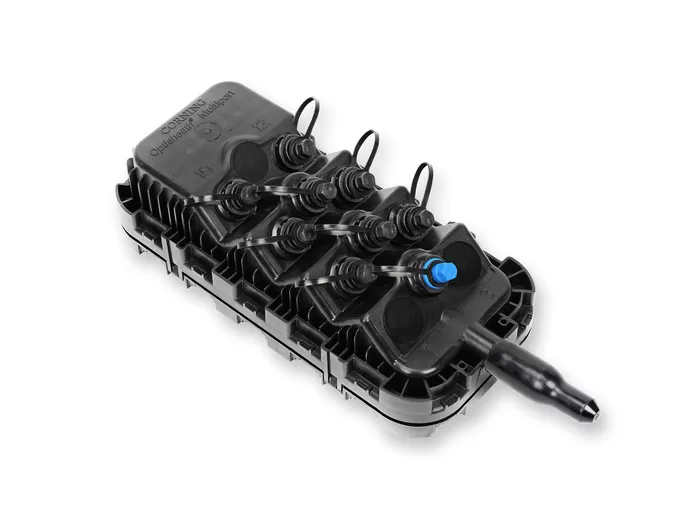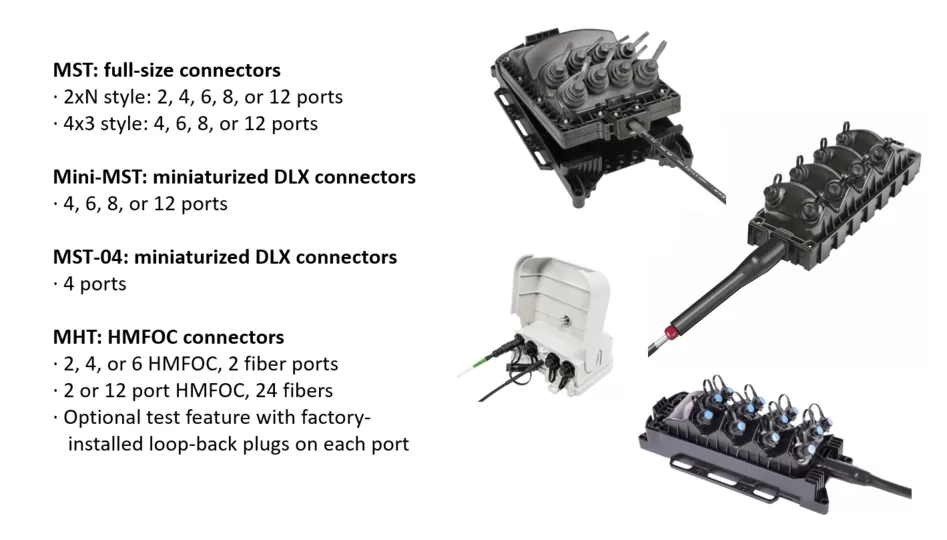Corning OptiSheath Multiport Terminal and CommScope MST (Multiport Service Terminal) are both industry-leading solutions for fiber optic access networks. They share some core functionalities but cater to slightly different needs. This in-depth comparison will dissect their specifications, features, and potential use cases to help you make an informed decision.
Introduction
Corning OptiSheath Multiport Terminal

Designed for outside plant (OSP) fiber access networks. Offers sealed environmental protection and easy incremental connection of subscriber drop cables.
CommScope MST (Multiport Service Terminal)

Renowned as the workhorse of access terminals. Built with hardened connector technology, it’s factory-terminated and environmentally sealed to withstand harsh outdoor environments.
Specification Comparison
| Feature | Corning OptiSheath Multiport Terminal | CommScope MST |
|---|---|---|
| Application | OSP Fiber Access Networks | OSP Fiber Access Networks |
| Housing Material | Plastic | Plastic |
| Port Configuration | Various configurations available (e.g., 2×6, 4×3) | Various configurations available (e.g., 2×6, 4×3, DLX) |
| Connector Type | SC, LC (depending on model) | SC, LC (depending on model) |
| Cable Type | Single-tube gel-filled (standard) | Single-tube gel-filled or loose tube (depending on model) |
| Environmental Sealing | Factory-sealed | Factory-sealed |
| Ingress Protection | Typically IP68 | Typically IP68 |
| Temperature Range | -40°C to +85°C (-40°F to +185°F) | -40°C to +85°C (-40°F to +185°F) |
| Deployment | Easy, incremental connection of drop cables | Easy, plug-and-play deployment |
Key Points:
- Both offer various port configurations to accommodate different network sizes.
- Connector types (SC and LC) are similar, but confirm compatibility with your chosen model.
- CommScope MST offers the option for loose tube cables, potentially providing greater fiber count capacity.
- Both boast excellent environmental protection with IP68 ratings and wide temperature tolerance.
Features Comparision
Corning OptiSheath Multiport Terminal:
- Toneable: Enables easier cable identification during installation and maintenance.
- Stubbed Design: Provides pre-terminated pigtails for faster drop cable splicing.
- Scalability: Allows for adding additional drop cables as the network grows.
CommScope MST:
- Plug-and-Play: Quicker deployment due to factory-terminated connectors.
- Hardened Connectors: Enhanced durability for harsh environments.
- DLX (Deluxe) Option: Offers increased port density for high-fiber count applications.
| Feature | Corning OptiSheath Multiport Terminal | CommScope MST |
|---|---|---|
| Toneable | Yes | No |
| Stubbed Design | Yes | No |
| Scalability | Easy addition of drop cables | Limited scalability after initial deployment |
| Plug-and-Play | No | Yes |
| Hardened Connectors | Optional | Standard |
| DLX Option | No | Yes |
Key Points:
- Corning’s toneable and stubbed design facilitate efficient installation and future expansion.
- CommScope’s plug-and-play nature and hardened connectors offer faster deployment and increased resilience.
- The DLX option in CommScope MST caters to high-density fiber networks.
Additional Considerations:
- Cost: Both solutions are likely comparable in price, but confirm pricing with vendors based on specific configurations.
- Availability: Check with distributors to ensure the chosen model is readily available in your region.
- Brand Preference: Some installers might have experience and preference for a particular brand.
Applications
Corning OptiSheath Multiport Terminal:
- Ideal for Greenfield deployments (building new fiber networks) due to its scalability.
- Suitable for situations requiring future network expansion.
- Well-suited for applications where easy cable identification is crucial (e.g., large campuses).
CommScope MST:
- Perfect for rapid deployment due to its plug-and-play design.
- Well-suited for established networks with limited future expansion needs.
- Ideal for high-density fiber applications with the DLX option.
Conclusion
Corning OptiSheath Multiport Terminal and CommScope MST are undeniably leading players in fiber optic access solutions. But what if there’s a more efficient way?
BATIV Technology steps into the arena, offering an alternative that might be the perfect fit for your needs. While both Corning and CommScope provide reliable options, BATIV could potentially deliver:
- Simplified Installation: Their solution might boast innovative features that streamline deployment, saving you time and resources.
- Enhanced Efficiency: BATIV’s technology could potentially offer advantages in terms of cost-effectiveness or ease of use.
- Unexplored Potential: Consider BATIV as a fresh perspective, potentially featuring unique functionalities not found in the established brands.
Don’t limit yourself to the usual suspects. Explore BATIV Technology and discover if it offers a more efficient path to building your fiber optic access network.
